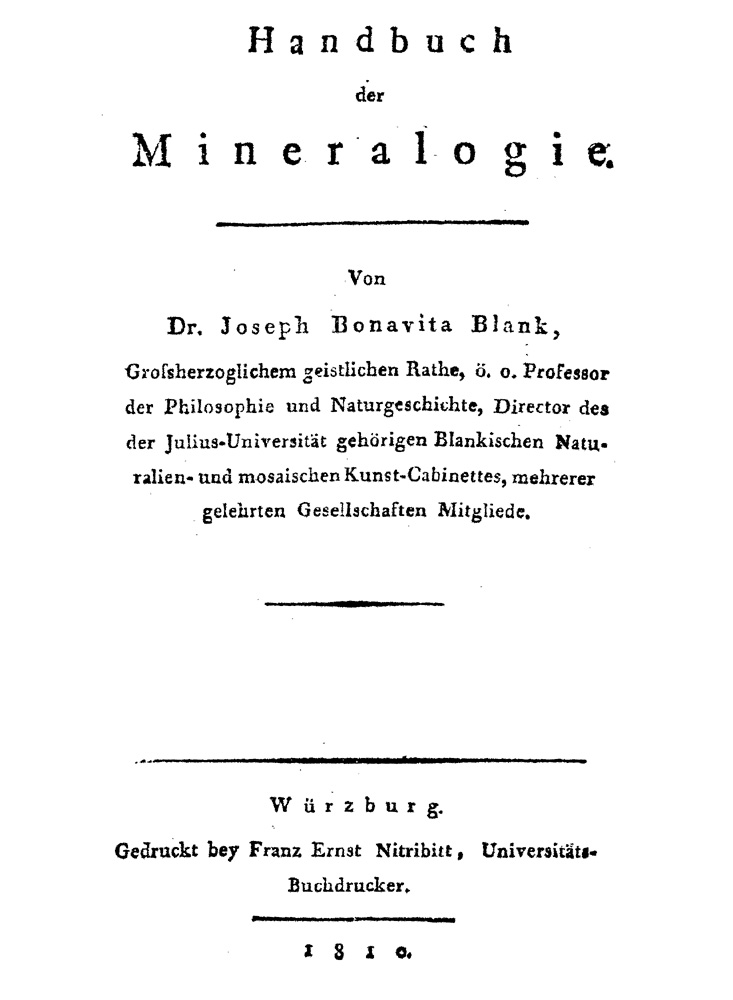BLANK, Joseph Bonavita.
(1740 – 1827)
Blank was a member of the Franciscan order and professor of philosophy and natural history at the University of Würzburg. He was also appointed curator of the University's art and natural history collections. In this position, he continued to successfully add to the collections, most especially when his own immense personal collections of art and natural history specimens were acquired by the University.
Biographical references: ADB: 2, 689. • Blank, J.B., Kurze Lebensbeschreibung. Mit dessen Bildnisse. Würzburg, Stahel, 1819. [i]-viiii, [1]-111, [1] p., frontispiece (portrait of Blank). [Autobiography of Blank, written in the third person with a bibliography.]. • DBA: I 106, 170-192; II 131, 169; 131, 196-202. • Hamberger & Meusel, Gelehrte Teutschland, 1796-1834. • Meusel, Verstorbenen Teutschen Schrifsteller, 1802-16. • Poggendorff: 1, col. 209. • Thieme & Becker, Allgemeines Lexikon, 1907-50. • WBI.
1. German, 1795.
Naturalien-Cabinet in dem Minoriten sogenannten Franciscaner-Kloster zu Würzburg gesammelt und geordnet von Bonavita Blank ... Würzburg, F.X. Rienner, 1795.
8°: [4], [1]-230, [2] p., plan.
Very rare. Published anonymously, but attributed to Blank. This is a catalog of the large collection of natural history objects (minerals, plants, animals) and other items such as drawings, porcelains and other art objects housed at the Franciscan monastery at Würzburg (later to become part of the University of Würzburg collections?).
Bibliographical references: BL [no copy listed]. • BMC: 1, ??. • GV (1700-1910): 16, 339. • Jonathan Hill, Bookseller: cat. 39, no. 21. • Murray, Museums, 1904: 3, 284. • NUC [no copy listed].
2. German, 1802.
Kurzer Bericht über die Vermehrung und dermahlige Einrichtung des Blankischen Naturalien-Cabinettes zu Würzburg, ... Würzburg, F.X. Rienner, 1802.
8°: [i]-xvi, [1]-119, [1] p.
Rare. A short account of Blank's personal natural history cabinet, which contained animals, minerals, birds, books, etc., together with a history of how the collection was brought together. Ultimately, his entire collection was acquired by the University of Würzburg.
Bibliographical references: BL [973.c.16.]. • Jonathan Hill, Bookseller: cat. 39, no. 21.

3. German, 1810.
Handbuch | der | Mineralogie. | [rule] | Von | Dr. Joseph Bonavita Blank, | [...5 lines of titles and memberships...] | [tapered rule] | [tapered rule] | Würzburg. | Gedruckt bey Franz Ernst Nitribitt, Universitäts- | Buchdrucker. | [rule] | 1810.
8°: π2 1-378 383; 301l.; [4], [1]-596, [2] p. Page size: 192 x 105 mm.
Contents: [2 pgs], Title page, verso blank.; [2 pgs], "Vorrede."-dated 21 April 1810.; [1]-596, Text.; [2 pgs], "Verzeichniss | der sinnstörenden Druckfehler."
Very scarce. The author's complete introduction to mineralogy based upon the theories of Werner. It was intended to accompany Blank's lectures at the University of Würzburg, however a contemporary review of this work, states: "This work intended as an introduction to the author's lectures, has many defects. For example, the author has often created mistakes in completeness by struggling to keep the the mineral descriptions brief. He also appears to have only a limited knowledge of so-called `new discoveries,' and the discussion of the various external characters is not ordered logically."
Bibliographical references: BL. • GV (1700-1910): 16, 339. • Leonard's Taschenbuch: 6, 309-10. • LKG: XII 185. • NUC [no copy listed].
4. German, 1810.
Uebersicht | des | Blankischen jetzt der großherzogl. Universität | zu Würzburg gehörigen | Naturalien= und mosaischen | Kunst=Kabinets, | nebst vorausgeschichter | Nachricht von den Lebensumständen seines | ehemaligen Eigenthümers und jetzigen | Direktors, des Herrn | Joseph Bonavita Blank, | [...2 lines of titles and memberships...] | [tapered rule] | Mit dem Bildnisse des Hrn. Direktors. | [tapered rule] | Bamberg und Würzburg, | bey Joseph Anton Goebhardt 1810.
8°: [1]-80 p., frontispiece (portait of Blank).
Very scarce. Blank describes in this catalog the large mineral collection he accumulated during his life, and which was acquired by the University of Würzburg in 1803 through part gift and part sale. The volume lists 11,395 specimens in the oryktognostische portion, 2144 examples in the geognostic, and a further 2882 petrifications. The frontispiece portrait shows Blank.
Bibliographical references: BL [B.448.(3.)]. • GV (1700-1910): 16, 339. • Leonard's Taschenbuch: 5, 338-39. • LKG: XV 51. • NUC [no copy listed].
5. German, 1820 [2nd edition].
Joseph Bonavita Blank's Beschreibung seiner Musivgemälde. Nebst kurzer Nachricht von dem Kunstsaale und einigen Zuwüchsen des Naturalien-Kabinets ... Joseph Bonavita Blank ... Zweite, verbesserte und vermehrte Ausgabe. Würzburg, 1820
8°: xx, 268, [2] p., engraved frontispiece, one folding engraved plate.
Rare. REWORK COMMENTARY: Prepared by Franz Georg Benkert, this description of Blank's collection of paintings also contains supplementary material concerning his natural history cabinet.The present work describes 61 landscape pictures (including a few portraits) and 133 bird pictures. In the introduction Blank gives a vivid account of his working methods and of a mammoth archive of ‘naturalia' collected on his travels and acquired from across the world, which he used in his work. None of Blank's work has endured the ravages of time and the only survivor in the Würzburg collection is a portrait of King Max I Joseph of Bavaria, executed by Blank's assistant Barbara Thein, and by a curious coincidence the frontispiece of the present catalogue.A first description of Blank's artistic output was published in 1796, the present edition is enlarged. Blank's Naturgemälde were displayed in the natural history cabinet of Würzburg University (whose curator Blank was and a description of which is appended). According to Thieme/Becker his work was a Europe wide attraction at the beginning of the 19th century.
.